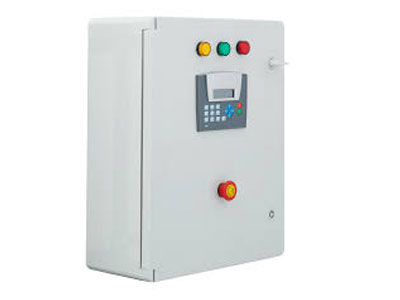What Is An HMI Control Panel?
Key Takeaway
An HMI, or Human Machine Interface, control panel is a digital dashboard or screen that allows users to control and monitor machinery. It is designed to replace manual controls with digital interfaces and graphical representations, making the control process more efficient and user-friendly. Operators interact with HMIs using input devices and visual displays to manage automated systems.
HMIs work by converting human instructions into machine language, enabling the equipment to operate accordingly. The use of HMI panels helps improve product quality, boost production rates, reduce work-related accidents, and lower hardware expenses. They are commonly found in factories and manufacturing facilities, where they monitor and control machinery, but HMIs are also used in various other applications like ATMs and mobile phones. HMIs are often deployed in multiple plant locations, each tailored to display relevant data for specific operator needs.
Definition and Purpose of HMI Panels
HMI panels are devices designed to present data from industrial equipment in a user-friendly manner. They serve as the primary interface through which operators interact with systems, input commands, and view critical performance metrics. By translating raw data into understandable visual formats, such as graphs, charts, and touchable icons, HMI panels enhance decision-making and reduce the learning curve for operating complex machinery.
The primary purpose of HMI panels is to provide real-time feedback and control, enabling operators to respond swiftly to changes and maintain optimal performance. This is especially valuable in high-stakes industries where accuracy and speed are crucial for productivity and safety.

Key Features of Modern HMI Panels
Modern HMI panels come with a range of advanced features to improve usability, connectivity, and system control. Key features include:
Touchscreen Displays: Allow for easy interaction and a clean interface that reduces the need for physical buttons.
High-Resolution Graphics: Present clear, detailed visuals, making it easier for operators to understand system statuses and anomalies.
Multi-Touch Capability: Enables more complex commands and gesture-based controls for efficient management.
Customization Options: Users can tailor the interface to display specific data or integrate particular controls relevant to their tasks.
Connectivity: Modern HMIs support various communication protocols like Ethernet, USB, and serial connections, enabling integration with other industrial devices.
Remote Access: Some HMI panels allow operators to monitor and control systems from remote locations, enhancing flexibility and response time.
These features help to create an interface that is both functional and user-centric, making daily operations smoother and less error-prone.
Integration with Industrial Automation Systems
HMI panels play a pivotal role in integrating industrial automation systems by acting as the communication hub between machinery, sensors, and control systems like PLCs (Programmable Logic Controllers). Through seamless data exchange, operators can monitor equipment performance, make real-time adjustments, and diagnose issues without needing to manually interact with the machinery.
Integration with PLCs allows HMIs to display live data and control processes, making them essential for coordinated operations. Additionally, connectivity with sensors and other devices helps in collecting input data, such as temperature, pressure, or flow, and presenting it in an easy-to-read format. This continuous flow of information supports better decision-making and minimizes potential downtime.
The ability to connect to different automation protocols like Modbus, OPC, and Profibus ensures that HMI panels can be integrated with various systems, regardless of the manufacturer. This adaptability extends their use across different industrial applications and setups.
Benefits of Using HMI Panels
The use of HMI panels brings numerous advantages to industrial operations:
Enhanced User Experience: Intuitive interfaces make it easy for operators to control and monitor systems, reducing training time and errors.
Improved Productivity: With real-time monitoring, operators can quickly identify and address issues, minimizing system downtime.
Data Visualization: HMIs present data visually, making it easier to track performance trends and make informed decisions.
Remote Monitoring: Operators can access system data and make adjustments from different locations, improving operational flexibility.
Customization: Interfaces can be tailored to suit specific needs, offering a more efficient workflow and user-centric experience.
Overall, HMI panels contribute to better operational control, increased productivity, and enhanced safety in industrial settings.
Common Applications of HMI Panels
HMI panels are found in a wide range of industrial applications, including:
Manufacturing: Used to monitor production lines, machinery, and assembly processes, ensuring smooth and continuous operation.
Automated Warehouses: Help manage robotic systems, conveyor belts, and inventory tracking systems for efficient storage and retrieval.
Energy Management: Employed in power plants and renewable energy facilities to monitor equipment, control processes, and ensure safe operations.
HVAC Systems: Facilitate control and monitoring of heating, ventilation, and air conditioning systems, optimizing energy use and maintaining comfortable environments.
Water Treatment: Used in water treatment plants for overseeing filtration systems, water pumps, and chemical dosing operations.
These applications highlight the adaptability of HMI panels in handling various processes, making them an indispensable part of modern industrial automation.
Conclusion
HMI panels have become a cornerstone of industrial automation, enhancing the way operators interact with machines and systems. From providing real-time data visualization to integrating seamlessly with automation technologies, the importance of HMI panels cannot be overstated. With their ability to improve productivity, offer remote access, and customize interfaces, they are key to optimizing industrial operations. The growing adoption of HMI panels continues to push the boundaries of how industries approach efficiency, safety, and control.

